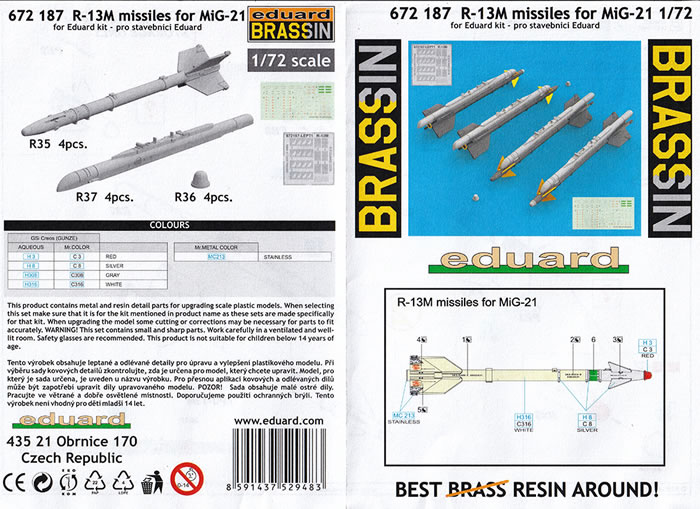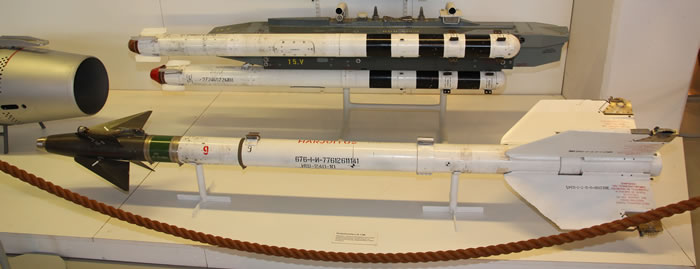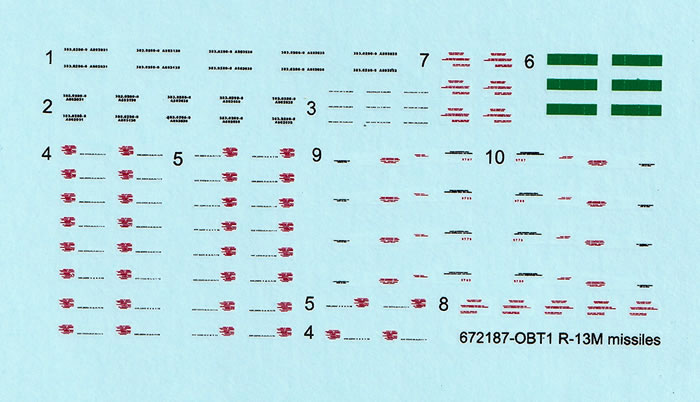R-13M Missile Set

Eduard BRASSIN, 1/72 scale
S u m m a r y : |
Catalogue Number: |
Eduard BRASSIN ED672187 - R-13M Missiles for Mikoyan MiG-21 |
Scale: |
1/72 |
Contents & Media |
12 grey resin cast parts to make 4 missiles, small photo-etch sheets, decals and instruction sheet. |
Price |
USD$9.95 plus shipping available online from Eduard
and hobby retailers online and worldwide |
Review Type: |
First Look. |
Advantages: |
Superbly detailed; Eduard’s usual clear instructions; clean moulding. |
Disadvantages: |
|
Conclusions: |
These missile sets are a great step up for any of Eduard's 1/72 scale MiG-21 kits, even the Royal Class boxing. |
Reviewed by David Couche

Eduard's 1/48 BRASSIN Spitfire Vb Gun Bays are available online from Squadron.com
The Vympel R-3 was one of the earliest Soviet air-to-air missiles to see operational service. It is also referred as the K-13. This missile has been used by the armed forces of many nations, and probably still sees some use in the Developing World. The K-13 is derived from the US-made AIM-9B Sidewinder. It should be noted that the R-3 designation applies to a family of missiles, but not to each model specifically. Western reporting name for these missiles is AA-2, or Atoll.

The origins of the R-3 are not rooted in a state requirement for a new air-to-air missile, but rather in a chance occurrence that seems almost like a work of fiction.
On September 24th 1958, Republic of China Air Force and People's Liberation Army Air Force (PLAAF) aircraft fought a series of battles in which the ubiquitous AIM-9 Sidewinder was first launched in anger. Following one of these battles, a PLAAF MiG-17 returned to base with battle damage after being hit by an AIM-9B. Upon examination after landing, the ground crew discovered that the missile had failed to explode, and was lodged almost undamaged in the fuselage. This missile was soon collected by Soviet engineers, and shipped to the Soviet Union, where it was gradually reverse-engineered
The R-3 series of missiles look almost exactly like the AIM-9B Sidewinder (see the page on that weapon for further details), all the way down to the trademark rolleron tabs on the tips of the aft fins. The R-3R however has a slightly longer fuselage, and a much longer nose, giving it an appearance distinct from any other Sidewinder derivative. The later R-13M is virtually indistinguishable in appearance from the AIM-9E, while the later R-13M1 looks more like the AIM-9J series of missiles, due to its small "cranked delta" forward fins with squared-off tips.
Remarkably, the construction of the R-3 missiles is identical to the Sidewinder, all the way down to their wiring and circuitry, which was confirmed in later years when the US government managed to covertly acquire some of them. Department of Defence and Raytheon engineers opened-up the "Atolls", and found that everything inside the R-3S was so accurately copied from the AIM-9B, that the two missiles had a 100% interchangeability of parts. The metallurgy and chemical composition of the R-3 missiles does not appear to have been published, but it is presumably the same as that of the Sidewinder.
The flight profile of the R-3 series is the same as that of the Sidewinder. Upon ignition, the rocket motor launches the missile to speeds in excess of Mach 2 (2 469 km/h) within a few seconds, by which time the short-lived fuel supply of the motor is already expended. The missile then travels to the target via glide and inertia, giving it increasingly less speed and maneuverability over distance. As the last traces of fuel burn-out, the missile self-destructs in mid-air.
The R-3 has been used in countless conflicts since the mid-1960s, as it was the default weapon for almost all variants of the MiG-21 fighters, and was also back-fitted to many other aircraft as well.
The R-13M is a much improved version of the R-3S and has capabilities similar to the AIM-9G Sidewinder. The R-13M is still a tail engagement missile only but is far more capable than the R-3S due to its new seeker and rocket motor. The new cooled seeker is more accurate and somewhat more resistant to countermeasures. The new rocket motor burns longer. The redesigned body makes the R-13M more maneuverable. The system is known as R-13M and the NATO designation is AA-2D Advanced Atoll. The designation AA-2-2 is sometimes used as well.
Eduard has released a set of the R-13M Missiles for the MiG-21. This set is a straight set of missiles with a set of APU-13 launching rails supplied as well.
The set gives you parts for 4 missiles. Each missile has 2 resin parts, a main body section and a choice of an alternative nose cover.
The missiles then have 4 etched front fins to be added, giving a far finer finished product than an injected moulded one or an all resin version. Care will need in the gluing of these parts, making sure they neatly go into the small recesses created for the etch parts.

Construction is simple with very little cleaning up, if any needed. This set also provides very neat 4 APU-13 Launchers that go onto the aircraft pylons to mount the actual missiles.

The Brassin instructions are 2 A5 pages of clear instructions, decal positioning and painting callouts, which are Gunze Aqueous and Mr Color referenced.
This is a very nice, well detailed and produced sets that will enhance your Eduard MiG-21 kit builds, regardless of them being a Weekend version, a Profipack or the Royal Class boxing. Use these and you will have some lovely detailed and classy ordinance hanging under the wing. .
Thanks to Eduard for the samples and images.
Review Text and Images Copyright © 2018 by David Couche
Page Created 15 April, 2019
Last updated
19 April, 2019
Back to HyperScale Main Page
Back to Reviews Page

|
